= Lithops karasmontana var. lateritia (Dinter) hort., nov. comb. ined.
Accepted Scientific Name: Lithops karasmontana N.E.Br.
Gard. Chron. 1926, Ser. III. lxxix. 102.
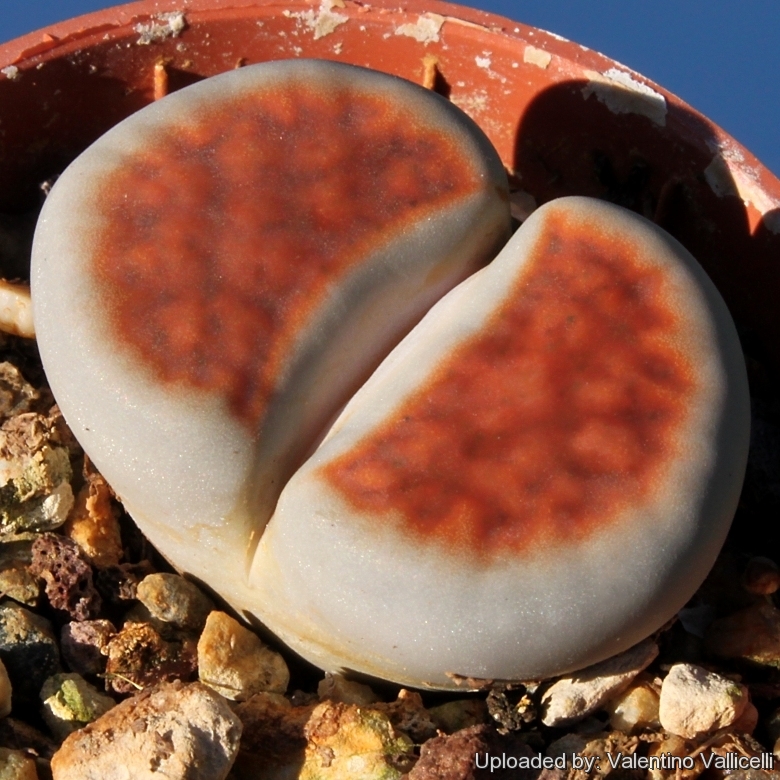
Lithops lateritia (Lithops karasmontana var. lateritia) Photo by: Valentino Vallicelli
Origin and Habitat: Namibia.
Synonyms:
See all synonyms of Lithops karasmontana
back
Accepted name in llifle Database:Lithops karasmontana N.E.Br.Gard. Chron. 1926, Ser. III. lxxix. 102.Synonymy: 41
- Lithops karasmontana N.E.Br.
- Lithops damarana (N.E.Br.) N.E.Br.
- Lithops karasmontana var. aiaisensis (de Boer) D.T.Cole
- Lithops karasmontana var. aiaisensis C224 TL: 110 km W of Karasburg, Namibia
- Lithops karasmontana var. aiaisensis C409 30 km E of Ai-Ais, Namibia
- Lithops karasmontana C065 (Signalberg Form) 25 km WNW of Grünau, Namibia
- Lithops karasmontana C168 (syn. mickbergensis) 10 km NNE of Grünau, Namibia
- Lithops karasmontana C169 (syn. mickbergensis) 20 km NNE of Grünau, Namibia
- Lithops karasmontana C223 25 km NE of Grünau, Namibia
- Lithops karasmontana C225 30 km NW of Grünau, Namibia
- Lithops karasmontana C226 25 km W of Grünau, Namibia
- Lithops karasmontana C227 (syn. jacobseniana) TL: 10 km SW of Grünau, Namibia
- Lithops karasmontana C317 (syn. mickbergensis) 15 km NE of Grünau, Namibia
- Lithops karasmontana C327 (syn. mickbergensis) 15 km NNE of Grünau, Namibia
- Lithops karasmontana C328 (Signalberg Form) 25 km WNW of Grünau, Namibia
- Lithops karasmontana C408 40 km NE of Ai-Ais, Namibia
- Lithops karasmontana var. lateritia (Dinter) hort., nov. comb. ined.
- Lithops karasmontana var. lericheana (Dinter & Schwantes) D.T.Cole
- Lithops karasmontana var. lericheana C193 50 km NNE of Grünau, Namibia
- Lithops karasmontana var. lericheana C267 TL: 70 km N of Karasburg, Namibia
- Lithops karasmontana var. lericheana C329 70 km N of Karasburg, Namibia
- Lithops karasmontana var. lericheana C330 70 km N of Karasburg, Namibia
- Lithops karasmontana var. mickbergensis (Dinter) de Boer & Boom
- Lithops karasmontana var. opalina (Dinter) de Boer & Boom
- Lithops karasmontana var. summitatum (Dinter) de Boer
- Lithops karasmontana var. tischeri D.T.Cole
- Lithops karasmontana var. tischeri C182 TL: 30 km NNE of Grünau, Namibia
Accepted name in llifle Database:Lithops karasmontana subs. bella (N.E.Br.) D.T.ColeLithops Flowering Stones 217 (1988)Synonymy: 7
Accepted name in llifle Database:Lithops karasmontana subs. eberlanzii (Dinter & Schwantes) D.T.ColeLithops Flowering Stones 219 (1988)Synonymy: 19
- Lithops karasmontana subs. eberlanzii (Dinter & Schwantes) D.T.Cole
- Lithops edithae N.E.Br. non Schwantes
- Lithops erniana Tischer ex H.Jacobsen
- Lithops erniana var. witputzensis de Boer
- Lithops karasmontana subs. eberlanzii C082 35 km E of Lüderitz, Namibia
- Lithops karasmontana subs. eberlanzii C147 (syn. erniana) 40 km S of Aus, Namibia
- Lithops karasmontana subs. eberlanzii C149 (syn. erniana witputzensis) TL: 110 km SSE of Aus, Namibia
- Lithops karasmontana subs. eberlanzii C208 10 km S of Aus, Namibia
- Lithops karasmontana subs. eberlanzii C209 (syn. erniana) 10 km SSE of Aus, Namibia
- Lithops karasmontana subs. eberlanzii C369 TL: 20 km E of Lüderitz, Namibia
- Lithops karasmontana subs. eberlanzii C370 35 km 35 km E of Lüderitz, Namibia
- Lithops karasmontana subs. eberlanzii C398 45 km E of Lüderitz, Namibia
- Lithops karasmontana subs. eberlanzii C399 45 km E of Lüderitz, Namibia
- Lithops karasmontana subs. eberlanzii C400 45 km E of Lüderitz, Namibia
- Lithops karasmontana subs. eberlanzii C401 25 km SE of Lüderitz, Namibia
- Lithops karasmontana subs. eberlanzii C404 50 km E of Lüderitz, Namibia
Cultivars
(8):
back
Description: Lithops karasmontanaSN|12138]]SN|12138]] var. lateritia is one of the innumerable local form of the very variable Lithops karasmontanaSN|12138]]SN|12138]] distingushed for the oval bodies with fissure extending right across, top surface quite homogeneous with brick-red or rusty-red tones. Flowers white. It has the same variable characteristics of the species.
Habit: Bodies solitary or in groups of 2 or more, to 3 cm high.
Stem: Almost stemless.
Bodies (Paired leaves): Inverted cone-like, divided into 2 unequal-sized, conjunct and coalescent leaves. Each 2,5-3 cm. Fissure fairly deep, 4-10 mm long. Top of lobe flat or subconvex; sides and top tinted a pale red-ochre, brick-red or bright rusty-red; window semi-opaque, surface slightly uneven, the depressions coloured darker than the ridges, which are coloured a deeper brick-red.
The plant renews itself every year or so by putting out a new plantlet from between the two lobes. Once the new plant is full sized, the old lobes shrivel up and slough off as a snake skin does.
Flowers: Big up to 4,5 cm in diameter (mostly 25-35 mm) satiny white, narrow-rayed.
Blooming season: Late summer or early autumn.
Fruit: Seed capsules mostly 5-chambered, otherwise 4 or 5-chambered. Profile boat-shaped.
Seeds: Minuscule, yellow-brown; smooth to rugose.
Subspecies, varieties, forms and cultivars of plants belonging to the Lithops karasmontana group
 Lithops karasmontana N.E.Br.: is uniformly coloured or variously ornamented. Plants from different localities show strikingly different colours or patterns. Distribution: Namibia. West and South West Great Karasberg, mainly in the Klein Karas, Grünau and and Ai-Ais.
Lithops karasmontana N.E.Br.: is uniformly coloured or variously ornamented. Plants from different localities show strikingly different colours or patterns. Distribution: Namibia. West and South West Great Karasberg, mainly in the Klein Karas, Grünau and and Ai-Ais. Lithops karasmontana var. aiaisensis (de Boer) D.T.Cole: has pale grey to brownish bodies, with darker grey to reddish-brown branched branched wrinkles, window usually absent. Distribution: Ai-Ais in Namibia.
Lithops karasmontana var. aiaisensis (de Boer) D.T.Cole: has pale grey to brownish bodies, with darker grey to reddish-brown branched branched wrinkles, window usually absent. Distribution: Ai-Ais in Namibia. Lithops karasmontana var. aiaisensis C224 TL: 110 km W of Karasburg, Namibia: pale stone grey.
Lithops karasmontana var. aiaisensis C224 TL: 110 km W of Karasburg, Namibia: pale stone grey.- Lithops karasmontana var. aiaisensis C409 30 km E of Ai-Ais, Namibia
 Lithops karasmontana var. aiaisensis cv. Orange top: reddish-orange tops.
Lithops karasmontana var. aiaisensis cv. Orange top: reddish-orange tops. Lithops karasmontana var. aiaisensis cv. Red Blushed Selection: (Mesa Garden 1625.3) Distinctive pale pastel top mottled orange-grey to reddish-orange. They are quite variable, no two plants look exactly the same.
Lithops karasmontana var. aiaisensis cv. Red Blushed Selection: (Mesa Garden 1625.3) Distinctive pale pastel top mottled orange-grey to reddish-orange. They are quite variable, no two plants look exactly the same. Lithops karasmontana subs. bella (N.E.Br.) D.T.Cole
Lithops karasmontana subs. bella (N.E.Br.) D.T.Cole- Lithops karasmontana subs. bella C108 TL: 5 km S of Aus, Namibia: jagged milky windows.
 Lithops karasmontana subs. bella C143A 60 km NNE of Aus, Namibia: striking zebraic pattern.
Lithops karasmontana subs. bella C143A 60 km NNE of Aus, Namibia: striking zebraic pattern. Lithops karasmontana subs. bella C285 Near Aus, Namibia: light grey, large windows.
Lithops karasmontana subs. bella C285 Near Aus, Namibia: light grey, large windows. Lithops karasmontana subs. bella C295 115 km SSE of Aus, Namibia: very wide jagged windows.
Lithops karasmontana subs. bella C295 115 km SSE of Aus, Namibia: very wide jagged windows. Lithops karasmontana C065 (Signalberg Form) 25 km WNW of Grünau, Namibia: red dots and lines, coarse.
Lithops karasmontana C065 (Signalberg Form) 25 km WNW of Grünau, Namibia: red dots and lines, coarse. Lithops karasmontana C168 (syn. mickbergensis) 10 km NNE of Grünau, Namibia: orange grey, variable.
Lithops karasmontana C168 (syn. mickbergensis) 10 km NNE of Grünau, Namibia: orange grey, variable. Lithops karasmontana C169 (syn. mickbergensis) 20 km NNE of Grünau, Namibia: orange grey.
Lithops karasmontana C169 (syn. mickbergensis) 20 km NNE of Grünau, Namibia: orange grey.- Lithops karasmontana C223 25 km NE of Grünau, Namibia: grey indented lines.
 Lithops karasmontana C225 30 km NW of Grünau, Namibia: grey green top, deep lines.
Lithops karasmontana C225 30 km NW of Grünau, Namibia: grey green top, deep lines. Lithops karasmontana C226 25 km W of Grünau, Namibia: stone grey body, red-green dots.
Lithops karasmontana C226 25 km W of Grünau, Namibia: stone grey body, red-green dots. Lithops karasmontana C227 (syn. jacobseniana) TL: 10 km SW of Grünau, Namibia: orange grey body.
Lithops karasmontana C227 (syn. jacobseniana) TL: 10 km SW of Grünau, Namibia: orange grey body. Lithops karasmontana C317 (syn. mickbergensis) 15 km NE of Grünau, Namibia: extremely varied.
Lithops karasmontana C317 (syn. mickbergensis) 15 km NE of Grünau, Namibia: extremely varied. Lithops karasmontana C327 (syn. mickbergensis) 15 km NNE of Grünau, Namibia: rough orange rocks.
Lithops karasmontana C327 (syn. mickbergensis) 15 km NNE of Grünau, Namibia: rough orange rocks.- Lithops karasmontana C328 (Signalberg Form) 25 km WNW of Grünau, Namibia: blurred red marks.
- Lithops karasmontana C408 40 km NE of Ai-Ais, Namibia
 Lithops karasmontana subs. eberlanzii (Dinter & Schwantes) D.T.Cole
Lithops karasmontana subs. eberlanzii (Dinter & Schwantes) D.T.Cole Lithops karasmontana subs. eberlanzii C082 35 km E of Lüderitz, Namibia: milky brown, mottled lines.
Lithops karasmontana subs. eberlanzii C082 35 km E of Lüderitz, Namibia: milky brown, mottled lines.- Lithops karasmontana subs. eberlanzii C147 (syn. erniana) 40 km S of Aus, Namibia: pink grey.
 Lithops karasmontana subs. eberlanzii C149 (syn. erniana witputzensis) TL: 110 km SSE of Aus, Namibia: light grey.
Lithops karasmontana subs. eberlanzii C149 (syn. erniana witputzensis) TL: 110 km SSE of Aus, Namibia: light grey. Lithops karasmontana subs. eberlanzii C208 10 km S of Aus, Namibia: brown-red lines.
Lithops karasmontana subs. eberlanzii C208 10 km S of Aus, Namibia: brown-red lines.- Lithops karasmontana subs. eberlanzii C209 (syn. erniana) 10 km SSE of Aus, Namibia: chicken foot scratches.
- Lithops karasmontana subs. eberlanzii C369 TL: 20 km E of Lüderitz, Namibia: pale or well-lined.
 Lithops karasmontana subs. eberlanzii C370 35 km 35 km E of Lüderitz, Namibia: decorator colors.
Lithops karasmontana subs. eberlanzii C370 35 km 35 km E of Lüderitz, Namibia: decorator colors.- Lithops karasmontana subs. eberlanzii C370A TL: 35 km E of Lüderitz, Namibia cv. Avocado Cream D.T.Cole: yellow green when ripe.
- Lithops karasmontana subs. eberlanzii C398 45 km E of Lüderitz, Namibia
- Lithops karasmontana subs. eberlanzii C399 45 km E of Lüderitz, Namibia
- Lithops karasmontana subs. eberlanzii C400 45 km E of Lüderitz, Namibia
- Lithops karasmontana subs. eberlanzii C401 25 km SE of Lüderitz, Namibia
- Lithops karasmontana subs. eberlanzii C402 40 km E of Lüderitz, Namibia cv. Avocado Cream
- Lithops karasmontana subs. eberlanzii C404 50 km E of Lüderitz, Namibia
- Lithops karasmontana subs. eberlanzii cv. Purper
 Lithops karasmontana var. lateritia (Dinter) hort., nov. comb. ined.: sensu Dinter!, bright rusty red top.
Lithops karasmontana var. lateritia (Dinter) hort., nov. comb. ined.: sensu Dinter!, bright rusty red top.- Lithops karasmontana var. lericheana (Dinter & Schwantes) D.T.Cole
 Lithops karasmontana var. lericheana C193 50 km NNE of Grünau, Namibia: light orange grey.
Lithops karasmontana var. lericheana C193 50 km NNE of Grünau, Namibia: light orange grey. Lithops karasmontana var. lericheana C267 TL: 70 km N of Karasburg, Namibia: dark jagged pattern.
Lithops karasmontana var. lericheana C267 TL: 70 km N of Karasburg, Namibia: dark jagged pattern. Lithops karasmontana var. lericheana C329 70 km N of Karasburg, Namibia: bold red humps.
Lithops karasmontana var. lericheana C329 70 km N of Karasburg, Namibia: bold red humps. Lithops karasmontana var. lericheana C330 70 km N of Karasburg, Namibia: mottled orange-grey.
Lithops karasmontana var. lericheana C330 70 km N of Karasburg, Namibia: mottled orange-grey.- Lithops karasmontana var. mickbergensis (Dinter) de Boer & Boom
 Lithops karasmontana var. mickbergensis cv. 99.44% white: pale selected form with a distinctive near white to clear pinkish top,some pink-orange.
Lithops karasmontana var. mickbergensis cv. 99.44% white: pale selected form with a distinctive near white to clear pinkish top,some pink-orange. Lithops karasmontana var. opalina (Dinter) de Boer & Boom
Lithops karasmontana var. opalina (Dinter) de Boer & Boom Lithops karasmontana var. summitatum (Dinter) de Boer
Lithops karasmontana var. summitatum (Dinter) de Boer- Lithops karasmontana var. summitatum cv. Red Selection
 Lithops karasmontana var. tischeri D.T.Cole
Lithops karasmontana var. tischeri D.T.Cole Lithops karasmontana var. tischeri C182 TL: 30 km NNE of Grünau, Namibia: rusty, deep lines.
Lithops karasmontana var. tischeri C182 TL: 30 km NNE of Grünau, Namibia: rusty, deep lines.- Lithops karasmontana cv. Top Red
Notes: Lithops karasmontanaSN|12138]]SN|12138]] is a choice example of the window-leaf ( fenestrate leaf) adaptation found in many other succulent species like Peperomia columnella, Fenestraria rhopalophyllaSN|11322]]SN|11322]], Haworthia truncataSN|11540]]SN|11538]], Ophthalmophyllum friedrichiaeSN|14645]]SN|14645]], etc. These windowed plants usually grows buried in the ground with only the upper truncated portion of the thick, succulent leaves visible. Both the coalescent leaf pair of Lithops (shaped like an inverted cone) and the leaves of the other windowed plants have a more or less upright position with the leaf tips at the soil surface or protruding only a little from the soil. The leaf tips either are rounded or flattened. This windows leaf tip is free of green pigments. The greater part of the photosynthetic leaf surface, the mantle, is not exposed directly to sun light since the leaf is embedded into the soil and the solar radiation is transmitted by the colourless water storage tissue to the assimilatory tissue, so the photosynthetically active mantle gets light only from inside the leaf and not across the epidermis. Moreover this light is more or less evenly dispersed over the whole assimilatory tissue since the water storage tissue disperses the solar radiation. All species of Lithops and Ophthalmophyllum have coloured windows that matches with the colours of the soil and the pebbles of the plant's habitat. While other window plants such as Haworthia maughaniSN|11538]]SN|11540]]i have dark green pigmented window areas. This green colour, however, does not result from a pigmentation of the window area but is the result of light that penetrates the window and is transmitted across the water storage tissue.
Bibliography: Major refences and further lectures
1) Heidrun E. K. Hartmann (2002) “Aizoaceae F – Z” Springer
2) Achim Hecktheuer (2008) “Mesembs, mehr als nur Lithops” Books on Demand GmbH Norderstedt. ISBN-13 978-3-8370-1724-3
3) Desmond T. Cole & Naureen A. Cole, Uwe Beyer, Yves Delange (2008) “Les Lithops” SUCCULENTES Spécial 2008 AIAPS (now Terra seca). ISSN 0258-5359
4) Desmond T. Cole & Naureen A. Cole (2005) “LITHOPS Flowering Stones” Cactus & Co. Libri. ISBN 88-900511-7-5 ISBN-13 978-88-900511-7-3
5) Yasuhiko Shimada (2001) “The Genus Lithops” Dobun Shoin. ISBN 4-8103-4066-X
6) Rudolf Heine (1986) “Lithops - Lebende Steine” Neumann Verlag. ISBN 3-7402-0000-6; ISBN-13 978-3-7402-0000-8
7) Bernd Schlösser (2000) “Lithops – Lebende Steine” Praktische Anleitung für die Zimmerkultur. BussinessPoint MEDIA. ISBN 3-934945-01-5; ISBN-13 978-3-934945-01-2
8) Steven A. Hammer (1999) “Lithops – Treasures of the veld” British Cactus and Succulent Society. ISBN 0-902-099-64-7; ISBN-13 978-0-902099-64-7
9) Desmond T. Cole (1988) “Lithops – Flowering Stones” Acorn Books CC. ISBN 0-620-09678-0; ISBN-13 978-0-620-09678-2
10) Rudolf Heine (1986) “Lithops – lebende Steine” Neumann Verlag. ISBN 3-7402-0000-6; ISBN-13 978-3-7402-0000-8
11) David L. Sprechman (1970) “Lithops” Associated University Presses, Inc. SBN 8386-6902-6
12) Gert Cornelius Nel (1946) “Lithops” Hortors Limited, South Africa
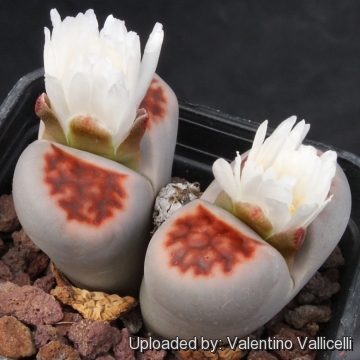 Lithops lateritia (Lithops karasmontana var. lateritia) Photo by: Valentino Vallicelli
Lithops lateritia (Lithops karasmontana var. lateritia) Photo by: Valentino Vallicelli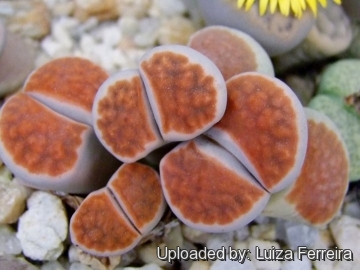 Lithops lateritia (Lithops karasmontana var. lateritia) Photo by: Luiza Ferreira
Lithops lateritia (Lithops karasmontana var. lateritia) Photo by: Luiza Ferreira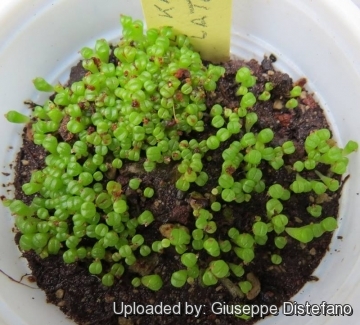 Seedlings. (Lithops karasmontana var. lateritia) Photo by: Giuseppe Distefano
Seedlings. (Lithops karasmontana var. lateritia) Photo by: Giuseppe Distefano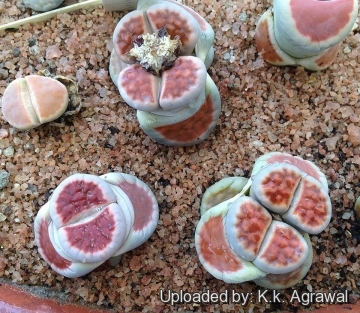 Lithops lateritia (Lithops karasmontana var. lateritia) Photo by: K.k. Agrawal
Lithops lateritia (Lithops karasmontana var. lateritia) Photo by: K.k. Agrawal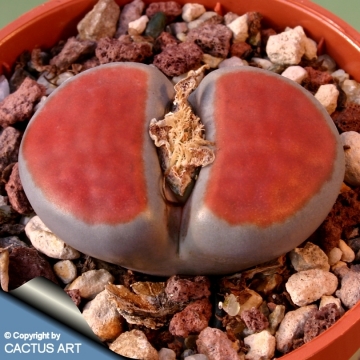 Lithops lateritia (Lithops karasmontana var. lateritia) Photo by: Cactus Art
Lithops lateritia (Lithops karasmontana var. lateritia) Photo by: Cactus Art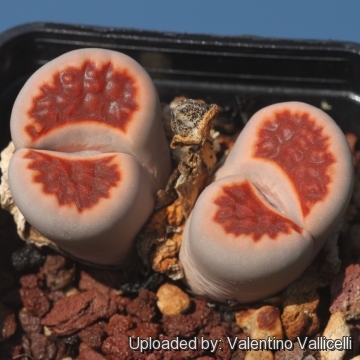 Lithops lateritia (Lithops karasmontana var. lateritia) Photo by: Valentino Vallicelli
Lithops lateritia (Lithops karasmontana var. lateritia) Photo by: Valentino Vallicelli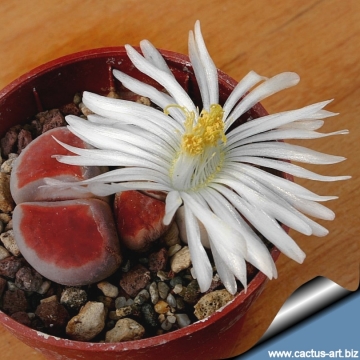 Lithops lateritia (Lithops karasmontana var. lateritia) Photo by: Cactus Art
Lithops lateritia (Lithops karasmontana var. lateritia) Photo by: Cactus Art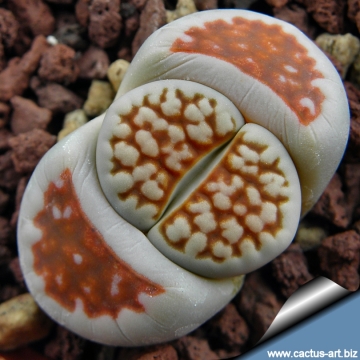 Lithops lateritia (Lithops karasmontana var. lateritia) Photo by: Cactus Art
Lithops lateritia (Lithops karasmontana var. lateritia) Photo by: Cactus ArtCultivation and Propagation: The Lithops (a.k.a. Living Stones) are some of the world's most fascinating plants and are sought by the collector of succulent plants. Paying attention to the particular growing requirement of Lithops is especially important. If you provide the Lithops with the right conditions, they will reward you with their unique shape, size, colour and a proliferation of blooms in autumn. However, Lithops are tricky plants that are very particular about their growing conditions and require the right maintenance in order to keep happy. But don't be afraid even the best growers have plants that mysteriously dry up, or leave during the night. While Lithops are picky about their care, if you are patient and remember the basics, your efforts will be rewarded. Being small plants, a representative collection can be grown on a patio table, a sunny windowsill or a shelf in the greenhouse.
Growing rate: Slow growing for a mesemb.
Soil: They grow best in an open mineral, sandy-gritty soil and requires good drainage as they are prone to root rot. They can grow outdoor in sunny, dry, rock crevices (protection against winter wet is required) They can also be cultivated in alpine house, in poor, drained soil.
Repotting: They may stay in the same pot for many years. Plants grown in larger containers have frequently relatively poor flowers. Flowers might improve when the plants are given their own, small individual pots.
Watering They Require little water otherwise the epidermis breaks (resulting in unsightly scars). The basic cultivation routine is: Stop watering after flowering. Start watering after the old leaves are completely dry (usually late March or Early April). Water freely during the growing season, soak the compost fully but allow it to dry out between waterings. In the winter season the plant doesn’t need watering, the plant in this time extracts water from the outer succulent leaves, allowing them to shrivel away, relocating water to the rest of the plant and to the new leaves that form during this period. If grown in a container, bottom watering by immersing the container is recommended. Water sparingly only when warm, no water when cold. Nearly all problems occur as a result of overwatering and poor ventilation, especially when weather conditions are dull and cool or very humid. They must have very dry atmosphere.
Fertilization: Feed them once during the growing season with a fertilizer specifically formulated for cactus and succulents (high potash fertilizer with a dilute low nitrogen), including all micro nutrients and trace elements diluted to ½ the strength recommended on the label. They thrive in poor soils and need a limited supplies of fertilizer to avoid the plants developing excess vegetation, which is easily attacked by fungal diseases. Some growers fertilize frequently, some hardly ever. However, for the highly succulent mesembs, (Lithops, Conophytums, etc.) fertilization is not really necessary.
Light: They prefer a very bright situation and in winter they need the maximum amount of light you are able to give them, but keep more cool and partially shaded in summer. The only exception to this is seedlings in their first year that enjoy a shades place. Such tiny plants can easily get scorched or broiled and their appearance spoiled (this may not matter in the wild, where the Lithops have probably shrunk into the ground and becomes covered with sands). Outdoor (Lithops prefer full sun, with some shade in the hottest summer months. High levels of light are needed in autumn to flower and for good plant development. The low intensity of sun light during the growing season of this species generally prevents the white flower flowers from opening.
Special Advice: Lithops are best planted in a sunny and airy part of the greenhouse, and not too close to the glass roof or sides of the house as the plants can overheat during hot spells.
Hardiness: They require a minimum temperature 5°C (But will take a light frost and are hardy down to -7° C for short periods if they are in dry soil). USDA zones 9A – 11.
Uses: Container, rock garden.
Pests & diseases: Lithops may be attractive to a variety of insects, but plants in good condition should be nearly pest-free, particularly if they are grown in a mineral potting-mix, with good exposure and ventilation. Nonetheless, there are several pests to watch for:
- Red spiders: they may be effectively rubbed up by misting the vulnerable plants every day.
- Mealy bugs: occasianlly they develop aerial into the new leaves and flowers with disfiguring results, but the worst types develop underground on the roots and are invisible except by their effects.
- Sciara Flies: they are one of the major problems for seedlings. It is a good practice to mulch your seedlings with a layer of grit, which will strongly discourage the flies.
- Scales, thrips and aphids: (they are rarely a problem.)
It is wise to treat your whole collection with a systemic insecticide twice a year in spring and autumn.
- Rot: it is only a minor problem with mesembs if the plants are watered and “aired” correctly. If they are not, fungicides won't help all that much.
Remarks: After flowering in the autumn and extending through winter season the plant doesn’t need watering, but they will still be growing, the new bodies will be increasing in size extracting water from the outer succulent leaves, allowing them to shrivel away. In fact the plant in this time extracts water and nutrient stored in the outer succulent leaves, allowing them to dehydrate relocating the water to the rest of the plant and to the new leaves that form during this period until the old leaves are reduced to nothing more than "thin papery shells".
Propagation: Seed or (or rarely) cuttings. The small seeds can be sown in pots of fine, well-drained sand, any time during the spring and summer months when temperatures are warm. Cover the seeds with a very fine layer of grit and water from below with a fungicide to prevent damping off. For the first 3-4 days cover the pots with a sheet of glass/clear perspex to keep the humidity levels high. Remove the glass and replace it with light shadecloth and mist once or twice a day for the next two weeks after which most seeds should have germinated. From then on mistings can be reduced to every second and then every third day as the little plants grow. Take the cuttings from a grown-up mother plant. Each cutting must contain one or more heads along with a fraction of root and permit them to dry out a couple of days, lay the cuttings on the soil and insert the stem end partially into the soil. Try to keep the cutting somewhat upright so that the roots are able to grow downward. It is relatively difficult to root Lithops from cuttings and generally pointless as well, so quick are they from seed.
Comment: Improvement of Lithops characteristics: Some growers (but not all!!) think it is very intriguing to reinforce any characteristic of cultivated Lithops of by crossing two similar selected plants and then back-crossing with the mother plant. This way we can eventually get some interesting results. Of course, many of the nicest Lithops we grow in cultivation have already been selected over time. However many Lithops are already nice plants which can’t really be improved, on the other hand one could try to improve the colour or the markings etc. Now if we have two particular plants we may attempt to breed between them and can maybe get a whole improved population and then select some better offspring to continue the selection.
Seed production: Plants can be hand pollinated, using a small paint brush. Remember always to cross different clones as the plants are self-sterile. The seed will remain viable for many years provided it is stored in a cool dry place.
Your Photos
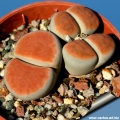
by Cactus Art
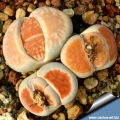
by Cactus Art

by Valentino Vallicelli

by Valentino Vallicelli

by Valentino Vallicelli
























